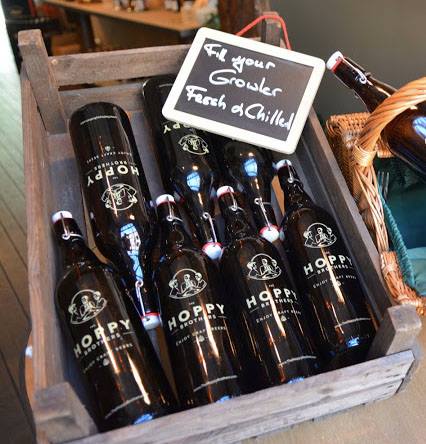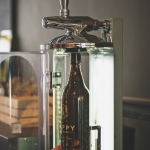What is a growler?
Growlers are a relatively new phenomenon, and while they’re not yet ubiquitous among craft beer drinkers, their popularity is growing all the time. This is because they combine, essentially, three great things: 1) access to limited edition craft beer, 2) super fresh beer, and 3) environmentally friendly packaging. If you live near a brewery (or two or three!) or a craft beer speciality shop with growler fill station like The Hoppy Brothers where growlers can be filled, then you’re in luck; no longer will your beverages at home be beholden to the classical bottle.

The Hardware
Growlers generally come in two different sizes, with some small variation between Europe and the United States. The larger, more common growler is 2 Liters, or 64 oz., while the smaller, slightly less common—but more portable—growler is 1 Liter, or 32 oz. Most growlers are composed of dark brown glass, intended to minimize the amount of light that contacts the beer. Some places, however, will even sell you a stainless steel growler, so that zero light comes into contact with the beer, and so the growler can be taken out onto a camping trip without worry that the glass might break. Once you have your growler—and once you’ve rinsed it out before its initial use—then you’ll head on down to a brewery, or to a tap room that fills growlers, choose yourself a beer, fill her up and take her home.
The Advantages of a Growler
One of the primary advantages of purchasing beer in a growler is that you can bring home beers that you’d otherwise need to be drinking out at a pub. Many breweries have specialty beers that they never put into a bottle or can, that never find their way into a retail shelf. If you want to try these beers within the comfort of your own home, and at a reduced cost vs. what you’d pay at the pub, then a growler is what you need. Whether it’s a limited release keg at the growler station, or a special beer available only at the brewery, the growler is the key to sipping a special, hard-to-find brew at home.
The second major advantage of using a growler is freshness. Although some beer styles age well (e.g. Imperial Stout), many, even most beers benefit from being consumed as soon as possible. Whether you’re after a crisp, refreshing lager, or a hoppy IPA, your beer will taste better with freshness on your side. If your beer has sat on a grocery store shelf for two months, it’s likely not ‘what the brewer intended.’ For an IPA especially, this is a death sentence. The citrusy, pine needle aroma and flavor that can make India Pale Ale such an enticing style are usually the first things to go when a beer ‘ages’ on the shelf, or even in the cooler. But if you are filling a growler, you’re much, much more likely to be drinking a fresh brew. In addition, the proprietor of your growler fill station should be able to tell you how long each of the kegs has been tapped, and sometimes even when each beer left the brewery. This means that, with a growler in hand, you can head home confident that the beer you’re about to drink is as fresh as possible—in some cases, only a few days old!
The third and final major advantage of growlers is their reduction of packaging waste. If your glass is shipped off to a recycling plant, rather than just heading to a landfill, it is at least being reused; the process of recycling it, however, uses a great deal of energy, energy that is conserved if you are using and reusing your own growler. But even if you return a case of bottles to be refilled by the same brewery (as is the case more frequently in Europe than in the United States), then the carbon footprint of hauling the bottles to and from the brewery is nonetheless larger than shipping the beer in aluminum kegs to growler stations, and bringing back the empty aluminum. Just about any way you look at it, growlers are the most environmentally sound option for beer drinkers.
What’s the Catch?
Despite their advantages, growlers do have a downside. A few years ago, Bon Appetit ran an article entitled “Why Beer Growlers are Bad for Your Brew.” In it, the author quotes Brooklyn Brewery’s brewmaster and famed beer guru Garrett Oliver, who discusses his “love-hate relationship” with growlers. “They’re often unsanitary,” says Oliver, “and the refilling process mixes in a lot of oxygen—the tiniest amount of oxygen kills beer so quickly.”
Aye, there’s the rub.
To assure the beer in your growler is the genuine article, the growler must be clean, and the beer must be consumed relatively quickly—ideally within 24-36 hours. This is the real limitation of growlers: their longevity. If you’re planning to have a few friends over to grill in your backyard this weekend, and you want to pick up beer in the middle of the week, a growler probably isn’t your best option.
But this limitation doesn’t mean growlers are necessarily “bad for your brew.” Improperly used, growlers will distort the flavor of a beer; but with some simple care, a growler can be a beer connoisseur’s best friend. First, when you’ve finished the beer in your growler, rinse it out right away. The small aperture, compared to the large volume, can make growlers difficult to clean, but if they’re rinsed immediately after use, then they can be kept sanitary quite easily.
Furthermore, some growler fill stations like the one at the Hoppy Brothers will even simply loan you a growler against a deposit, take it back once you’ve finished your beer, and clean it for you professionally, assuring that your beer has a sanitary vessel.
Second, you should fill your growler knowing that you’re going to consume it in the near future. Are you having some friends over for a BBQ next weekend? Are you heading out to buy beer for this evening? Buying some beer to head straight out to the park for a picnic this afternoon? That’s when a growler is a prime candidate. Growlers are not an infallible beer delivery system, but when used properly, they allow the consumer to enjoy fresh beer, beer often otherwise unavailable for retail sale, and do so with the minimal environmental impact; I’ll drink to that.


